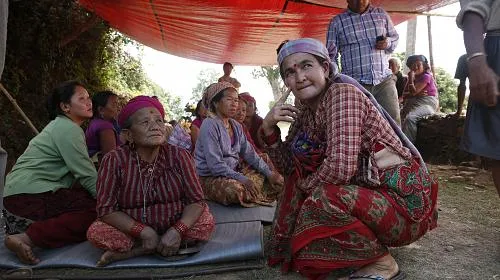KATHMANDU, Nepal (June 5, 2015) – As the monsoon season begins across Nepal, CARE is worried about the large numbers of people sleeping outdoors without any kind of permanent shelter; many in the remotest parts of the country. It is a race against time to provide key assistance to people who have been affected by the earthquake before many areas become totally cut off. CARE is prioritizing emergency shelter and hygiene and sanitation for these communities.
CARE is providing corrugated iron sheeting to some 6,000 households of around 30,000 people to help them build durable and watertight structures which can protect them for the coming three months. CARE is also providing technical support to people in building these temporary shelters to make sure they withstand the monsoon conditions.
“Our biggest priority now is to make sure we get people through the monsoon safe and dry. Families want to know how to rebuild their homes safer and better and our job is to help them do this,” CARE shelter expert Tom Newby said.
There remains a great concern that the monsoon rains will cause further landslides in the already fragile hillsides which have been left with deep fissures and cracks after the two big earthquakes that hit the country in April and May. People in remote communities who are currently living in temporary shelters have told CARE staff that they are worried about the land they are living on and fear it may fall from under them at any point.
CARE is anticipating that already damaged roads will become even more inaccessible as a result of the rains and landslides and it will become almost impossible to reach many remote communities. CARE emergency team leader Heather Van Sice says, “We will target the areas that have been hardest hit and where access is most likely to be cut off first.”
The risk of an outbreak of waterborne disease also remains a real concern with people sleeping outside and many household latrines destroyed. People are having to walk long distances to find functioning latrines or are often forced to use open spaces. CARE is making the prevention of disease outbreak a priority in its monsoon planning. Van Sice notes; “Many of the underground parts of people’s household latrines remain intact so we will work with them to clear away the rubble and build back the superstructures so they start reusing their latrines and reduce the risk of disease outbreaks as soon as possible.”
Some eight million people have been affected by the earthquake, with over 750,000 houses damaged or destroyed and close to 9,000 people killed, according to Government of Nepal figures. Trainings on key safe construction techniques, information on how to build back safer through radio and other channels as well as the provision of building materials such as cement will be critical over the coming months. CARE has already reached over 33,500 people since the first earthquake on April 25 and plans to reach around 100,000 in the coming months.
CARE has launched an appeal for $40 million to assist people in some of the hardest-hit communities. To date, $12.8 million has been raised worldwide. The funds will provide emergency assistance to people affected by the disaster in Nepal, as well as support communities as they rebuild in the years to come.
About CARE
Founded in 1945, CARE is a leading humanitarian organization fighting global poverty. CARE has more than six decades of experience helping people prepare for disasters, providing lifesaving assistance when a crisis hits, and helping communities recover after the emergency has passed. CARE places special focus on women and children, who are often disproportionately affected by disasters. To learn more, visit www.care.org.
Media Contact
Holly Frew, hfrew@care.org, +1.770.842.6188

